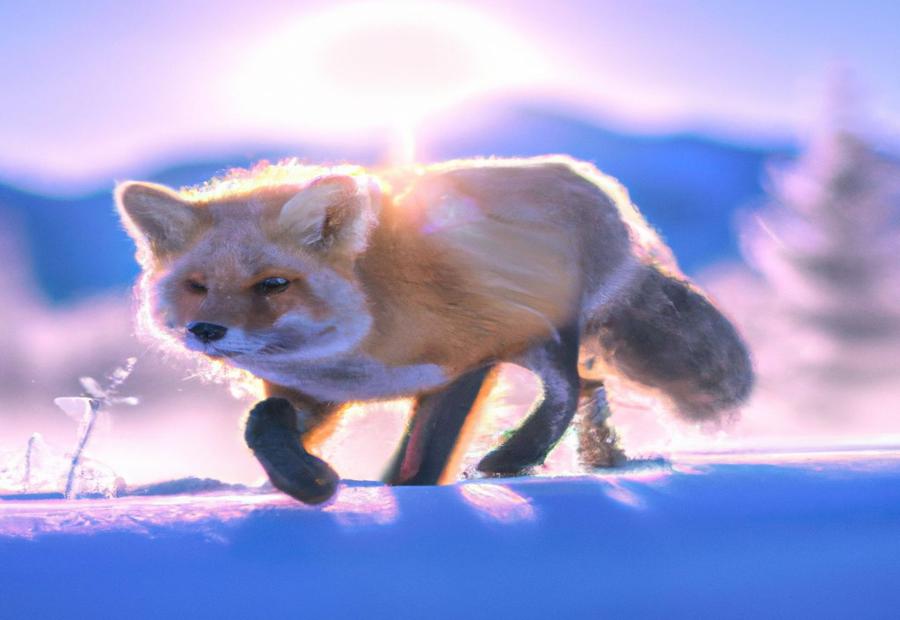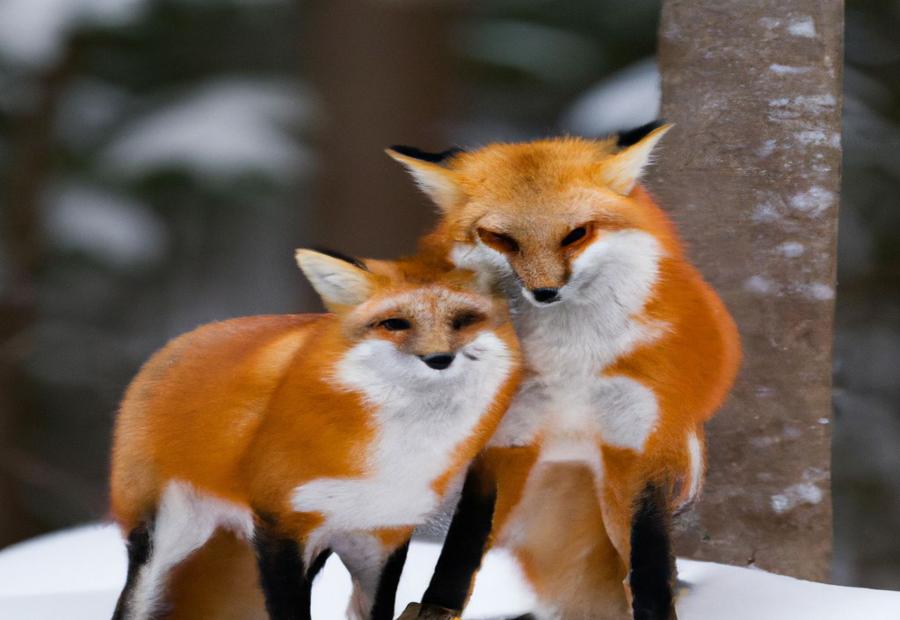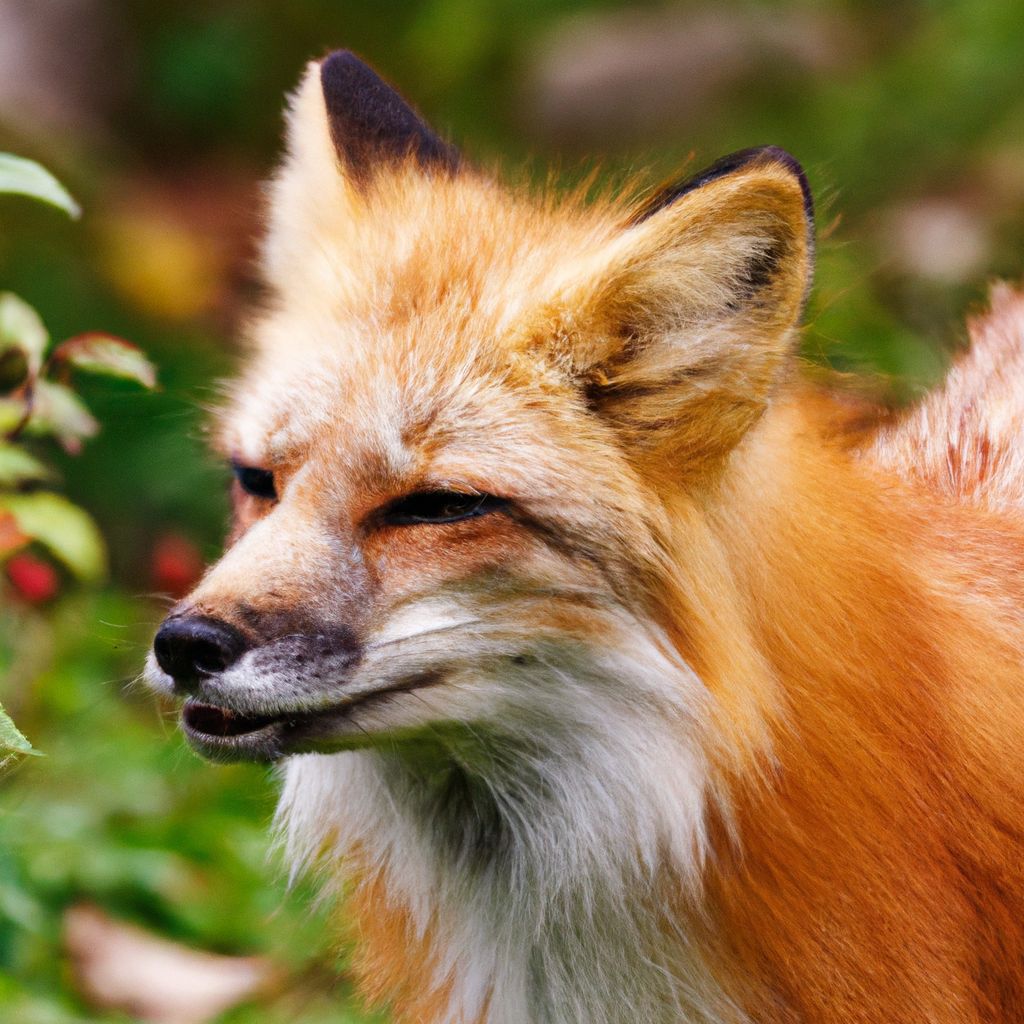The Red Fox, scientifically known as Vulpes vulpes, is a fascinating and resilient creature that thrives in various habitats, including winter landscapes.
Red foxes have evolved unique survival strategies that enable them to endure harsh winter conditions and ensure their continued existence.
This article explores the prospects and challenges of red fox domestication including their adaptations for cold weather, hunting techniques, and food sources.
It also delves into their mating and reproductive behaviors during the winter season.
we will examine the challenges that red foxes face in winter, such as the lack of food and competition with other predators.
Finally, we will discuss the importance of conservation and effective management practices to ensure these remarkable creatures’ survival in winter.
A comprehensive understanding of red foxes’ winter survival strategies is crucial for conservation efforts and maintaining a healthy ecosystem.
Contents
- 1 Winter Survival Strategies of Red Foxes
- 2 Mating and Reproduction During Winter
- 3 Challenges Faced by Red Foxes in Winter
- 4 Conservation and Management of Red Foxes in Winter
- 5 Frequently Asked Questions
- 5.1 1. How do red foxes survive in winter?
- 5.2 2. What are some adaptations of red foxes for winter survival?
- 5.3 3. Where are red foxes found during winter?
- 5.4 4. What is the diet of red foxes in winter?
- 5.5 5. How do red foxes protect themselves and their young during winter?
- 5.6 6. How long do red foxes live and when do they mate?
Winter Survival Strategies of Red Foxes

Photo Credits: Foxauthority.Com by Daniel Hernandez
Winter is a tough time for red foxes, but they have some remarkable strategies up their sleeves. From adapting to the frigid temperatures to mastering hunting techniques in the harshest conditions, these cunning creatures know how to survive. In this section, we’ll uncover the secrets behind the red foxes’ winter survival. We’ll explore their adaptations for cold weather, their clever hunting techniques, and the diverse food sources they rely on during the harsh winter months. Get ready to dive into the fascinating world of red foxes in winter!
Adaptations for Cold Weather
The red fox possesses various adaptations for cold weather. These include a dense coat of fur, smaller limbs, a voluminous tail, sturdy paws, and an increased capacity for food storage.
The thick fur of the red fox functions as insulation, effectively retaining heat close to its body. Its diminutive ears and nose aid in minimizing heat loss, thus protecting against frostbite.
Additionally, the fox has the ability to envelop its bushy tail around its body, providing supplementary warmth. The substantial fur on its paws shields its feet from the frigid ground and facilitates better grip on slippery surfaces.
In preparation for winter, the red fox diligently hoards extra food in concealed locations. Safeguarding natural habitats and mitigating conflicts between humans and wildlife are imperative for the continued survival of the red fox throughout the winter season.
Hunting Techniques in Winter
In winter, red foxes utilize a variety of ingenious hunting techniques to effectively survive the harsh conditions. These specialized methods enable them to locate and secure prey efficiently. Here is a step-by-step breakdown of their hunting strategies during the winter season:
1. Stealth and Patience: Red foxes heavily rely on their exceptional hearing and sharp eyesight to detect potential prey. To avoid being noticed, they employ a remarkably quiet approach.
2. Pouncing on Unsuspecting Prey: Once a red fox spots its prey, it skillfully employs its powerful hind legs to launch a precise and agile pounce.
3. Sprinting to Capture Swift Prey: Capable of reaching speeds up to 30 miles per hour, red foxes use short bursts of speed to successfully capture fast-moving prey like rabbits or squirrels.
4. Snow Digging: The presence of snow on the ground can make it challenging for red foxes to access burrowing prey. However, they adeptly overcome this obstacle by utilizing their sharp claws to dig through the snow, uncovering hidden creatures such as mice or voles.
5. Acute Listening Skills: Red foxes possess exceptional hearing, allowing them to detect movements occurring beneath the snow. They cleverly position themselves above the source of sound and swiftly dive headfirst to catch their elusive prey.
6. Opportunistic Approach: Red foxes are highly adaptable and resourceful hunters. During winter, they take advantage of any available food source, including scavenging carrion or relying on food caches established during more abundant times.
By employing these ingenious hunting techniques, red foxes skillfully navigate the challenges brought about by winter, ensuring their survival throughout the cold season.
Food Sources in Winter
During the winter season, red foxes rely on a variety of food sources to ensure their survival. These food sources include small mammals such as mice, voles, and rabbits, which serve as a consistent prey for them. In times when other food sources are scarce, red foxes turn to birds, particularly injured or weak ones. Additionally, they scavenge the carcasses of larger animals, like deer, that couldn’t withstand the harsh winter conditions, a food source known as carrion. Although insects and fruits are less abundant during winter, red foxes may still consume insects found in leaf litter or tree bark, as well as the remaining fruits or berries. In urban areas, red foxes resort to scavenging discarded food or small animals attracted by human activity.
The importance of these food sources becomes evident in the story of Rosie, a red fox in Maine, USA, who faced extreme food shortages due to heavy snowfall. Rosie’s survival during winter was made possible by visiting a local farm where excess food was provided for her. This act of kindness demonstrated the resourcefulness of red foxes and the positive impact that human assistance can have on wildlife during challenging times.
Mating and Reproduction During Winter

Photo Credits: Foxauthority.Com by Dennis Young
When winter sets in, the natural world goes through remarkable transformations, and one intriguing aspect is the mating and reproduction habits of the red fox. In this section, we will dive into the fascinating world of red foxes during winter by exploring the breeding season and their unique strategies for nesting and denning. Get ready to unveil the secrets of how these resourceful creatures ensure the continuation of their species even in the harshest winter conditions!
Breeding Season
The breeding season of red foxes is a crucial time for reproduction and population growth. It occurs from January to March, in late winter and early spring. During this season, male red foxes (dogs) and female red foxes (vixens) engage in mating rituals, using vocalizations and markings to attract each other. The breeding pairs usually stay together until the kits are born. The gestation period for red foxes is approximately 51 to 53 days. Vixens create dens, often in burrows, hollow trees, or secluded areas, for giving birth to their kits. On average, red foxes give birth to 4 to 6 kits during the breeding season. Both the male and female take an active role in raising the kits, providing them with food, protection, and guidance until they can fend for themselves.
The breeding season is a fascinating time for red foxes, as they exhibit various behaviors and strategies to ensure the survival and growth of their population. Understanding these aspects of their breeding season is essential for the conservation and management of red foxes in their natural habitats.
Nesting and Denning
Red foxes engage in nesting and denning during the winter season to ensure the survival of their offspring. Here are some key aspects to consider:
1. Nesting sites: Red foxes typically select secluded locations for their nests, such as abandoned burrows, hollow logs, or dense vegetation. These sites provide protection and insulation from winter weather.
2. Construction of dens: Red foxes are skilled diggers and can create complex underground dens. The den consists of a tunnel entrance leading to a larger chamber where the foxes rest, give birth, and raise their young.
3. Mating and reproduction: Red foxes have a specific breeding season during winter. After mating, the female prepares the den for the arrival of her offspring. The gestation period lasts around 52 days before she gives birth to a litter of typically 4-5 pups.
4. Nurturing the young: The female fox stays in the den with her pups for the first few weeks, providing warmth and nourishment. The male fox assists by bringing food to the den, ensuring the survival and well-being of the entire family.
5. Protection and safety: Nesting and denning provide a secure environment for the vulnerable pups. The den offers protection against predators and extreme weather conditions, creating a nurturing space for the young foxes to grow and develop.
To support red foxes during nesting and denng, it is important to preserve their natural habitats by minimizing human disturbances and protecting areas with suitable nesting sites. By doing so, we can contribute to the successful reproduction and survival of these fascinating creatures.
Challenges Faced by Red Foxes in Winter
Winter can be an unforgiving season, especially for the resilient red fox. As we delve into the challenges faced by these cunning creatures, we’ll uncover a struggle for survival that forces them to confront a harsh reality. From the scarcity of food to intense competition with other predators, and the relentless onslaught of harsh weather conditions, the red fox’s winter survival hangs by a thread. Brace yourself as we explore the intricate web of challenges that these remarkable animals navigate to endure the coldest of seasons.
Lack of Food
Red foxes encounter a lack of food issue in winter that can have a notable effect on their survival. Their primary source of sustenance consists of small mammals such as mice and voles. However, these creatures become scarce during the colder months due to reduced activity and hibernation.
To adapt, red foxes employ various strategies. They broaden their diet by scavenging for carrion or consuming fruits and berries when available. In addition, they have the capability to hunt larger prey like rabbits or birds to obtain a more substantial meal. Furthermore, red foxes engage in food storage by burying it in shallow holes or under leaves for future consumption.
A real-life account highlights the difficulties red foxes encounter when it comes to finding food during winter. Rosie, a female red fox, resided in a suburban area where human development greatly impacted her hunting grounds. Faced with a scarcity of natural prey, Rosie had to scavenge for leftovers left by humans. Despite her tireless efforts, she struggled to locate sufficient food, resulting in malnutrition and a decline in overall health. This example demonstrates the significant consequences of a lack of food on red fox populations and emphasizes the importance of conserving natural habitats to ensure their continued survival.
Competition with Other Predators
Competition with other predators is a critical challenge that red foxes in winter have to face. Being carnivores, red foxes rely on hunting for their survival. However, they encounter competition from various animals, such as coyotes, wolves, and other foxes, for prey when food becomes scarce. In order to thrive, red foxes employ their adaptability and cunning hunting skills. They employ stalking, pouncing, and chasing tactics and heavily rely on their sharp senses to detect prey.
Additionally, they possess the ability to conceal their scent, making it more difficult for predators to track them down. Red foxes may adjust their hunting strategies depending on the presence of other predators, which includes changing their hunting grounds or targeting different prey. Overcoming competition is of utmost importance for the survival of red foxes.
Harsh Weather Conditions
Harsh weather conditions pose challenges for red foxes during winter. To survive, red foxes seek shelter in dens or burrows, utilizing their thick fur as insulation to retain heat. In extreme cold, red foxes conserve energy by lowering their metabolic rate. Additionally, they store extra food in caches, allowing them to access it when food becomes scarce. Some red foxes even migrate to more favorable areas with milder climates and more abundant food. These strategies and adaptations enable red foxes to endure and survive the harsh winter conditions.
Conservation and Management of Red Foxes in Winter
Red foxes face unique challenges in their winter survival, but through effective conservation and management, we can ensure their thriving population. By focusing on the preservation of natural habitats and minimizing human-wildlife conflict, we can foster a harmonious coexistence. Let’s discover how these strategies play a vital role in safeguarding the red foxes during the harsh winter months and maintaining a balanced ecosystem.
Preservation of Natural Habitats
Preservation of natural habitats is of utmost importance for the survival of red foxes during the harsh winter months. It is crucial to protect the environments in which red foxes reside.
Firstly, it is necessary to conserve forests and woodlands as these habitats offer shelter, protection, and den sites for red foxes. By preserving these areas, we ensure that red foxes have suitable locations to rest and rear their young during the winter season.
Secondly, it is essential to safeguard open spaces and grasslands as they are significant hunting grounds for red foxes. Conserving these habitats guarantees an ample food supply and hunting opportunities, particularly during the scarce winter months.
Thirdly, the management of wetlands is vital for red foxes as these areas provide diverse food sources and attract small mammals and birds. It is important to maintain the health of wetlands by managing water and limiting pollution in order to support the red fox population.
Furthermore, the creation of wildlife corridors plays a crucial role. These corridors connect natural habitats, enabling red foxes to move between areas in search of food, mates, and suitable den sites. Protecting and maintaining these corridors allows red foxes to adapt to changing environmental conditions.
Lastly, it is essential to strike a balance between human activities and the preservation of natural habitats. Minimizing conflicts and disturbances caused by human activities is crucial. Implementing measures such as responsible land development and wildlife-friendly practices can help preserve natural habitats for urban red foxes without compromising human needs.
By prioritizing the preservation of natural habitats, we can effectively support the survival of red foxes in winter and contribute to the conservation of this fascinating species.
Minimizing Human-Wildlife Conflict
Minimizing human-wildlife conflict can be achieved through the following steps:
1. Education and awareness: Educate individuals about red fox behaviors and needs to minimize conflicts and promote coexistence. For more insights into the lives of Arctic Foxes, you can watch the show “Arctic Foxes: Insights into their Lives” on Animal Planet.
2. Proper waste management: Secure trash cans and dispose of food waste properly to reduce the risk of conflict.
3. Protecting livestock: Implement proper fencing and housing to ensure animal safety and prevent predation in areas where red foxes may pose a threat.
4. Limiting attractants: Avoid attracting red foxes to residential areas by limiting access to pet food, bird feeders, and uncovered compost piles. It is also important to explore the diet of red foxes and understand what they like to eat. You can find more information about their diet here.
5. Creating buffer zones: Establish natural barriers between human habitats and red fox habitats to reduce encounters and conflicts. For more information about identifying the predators of foxes, you can refer to our comprehensive guide.
6. Implementing deterrents: Use non-lethal deterrents like motion-activated lights, noise devices, or scent repellents to discourage red foxes from entering human-occupied areas.
7. Reporting and seeking assistance: Report conflicts or nuisances caused by red foxes to local wildlife authorities or conservation organizations for appropriate resolution.
By following these steps, Arctic foxes in zoos can learn to adapt and survive in their habitat, minimizing any conflict with humans and allowing both species to coexist harmoniously.
Frequently Asked Questions
1. How do red foxes survive in winter?
Red foxes survive in winter by adapting to the cold weather through various physiological and behavioral adaptations. They grow longer and thicker fur to keep warm, use their hearing to locate hidden prey, and curl up in the open, covering themselves with their tail to protect against the cold.
2. What are some adaptations of red foxes for winter survival?
Red foxes have several adaptations to help them survive harsh winters. They grow thicker fur, have extra fat on their bodies, and decrease their activity. They also have a low surface area to volume ratio, camouflaged seasonal fur, and a countercurrent heat exchange mechanism in their paws to minimize heat loss.
3. Where are red foxes found during winter?
Red foxes are found in various regions around the world, including North America, Europe, northern Africa, and temperate regions of Asia. They have adapted to inhabit different environments and cope with different weather conditions, including cold winter months.
4. What is the diet of red foxes in winter?
The diet of red foxes in winter varies according to seasonal abundance. They primarily feed on small mammals like rabbits, rodents, and squirrels. They also eat grubs, insects, and rely on their sharp hearing to detect mice even under the cover of snow.
5. How do red foxes protect themselves and their young during winter?
Red foxes protect themselves and their young during winter by sheltering in burrows they dig in the snow, curling into a ball to conserve heat, and wrapping their tail around their bodies for extra warmth. The cubs are hidden in tunnels in the snow, and the adult foxes provide food for them.
6. How long do red foxes live and when do they mate?
Red foxes have a lifespan of 12-18 years in urban areas and three years in the wild. They mate during winter and form monogamous pairs. The female foxes stay in dens while the male foxes feed the cubs. The cubs reach maturity after ten months.


